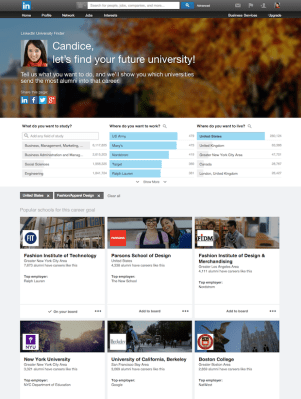Last year, LinkedIn widened the net for potential users when it started to allow high schoolers to join its social network for professionals, and today it’s launching a clutch of features that it hopes will get them to stick around a while longer: three new tools — Decision Boards, University Outcome Rankings and University Finder — focus on college-bound students who are deciding where to apply, what to study and people who might give them some useful advice on the way.
And while the company has been doing a lot of development on monetising and advertising and premium membership, these are areas that are not getting touched in the new tools, the company tells me: “This is free for all people and universities cannot pay for better placement,” a spokesperson told me in answer to a question about sponsored placements (a la Google in its search results). “These rankings are based on the career outcomes of LinkedIn members.”
The first tool, Decision Boards is akin to Belly (the advice/Q&A app from Twitter alums), and lets people call on their networks, and others, for advice on things like what school to attend, what subjects to study and so on. You can also use it to start meeting people at your potential school before you get there by tagging the school in your question. LinkedIn describes Decision boards as a “first-of-its-kind social decision-making tool.”
University Outcome Rankings is LinkedIn’s big data play: millions of alumni profiles get analysed to produce a ranking of how schools fare based around particular careers — and presumably how successful certain graduates have been. The catch here is that it’s confined only to those who are on LinkedIn, meaning that some professions, and some schools, and some geographies may end up woefully underrepresented in the mix.
The third of these, the University Finder, is basically a tool to look for universities that is “personalised” to you: it takes parameters like your intended career, and even where you would one day like to work, to match you up with compatible institutions. Presumably there will be high and predictable correlations between places like Stanford and computer science and working at Google, Apple or another major Silicon Valley firm. Again, whether this will be able to surface more nuanced suggestions will have to be seen.
The new features are a clever move for the company: the tools could lead to more engagement from a coveted demographic, but they will also help LinkedIn build up its profile with universities themselves. Higher education is another target for the company. LinkedIn last year started to let colleges create dedicated pages for themselves, and as LinkedIn evolves its platform further you can see how it could position itself as a useful bridge between those who are studying and those who are transitioning into the working world — a role that colleges have often tried to fill but have often fallen short.
The idea of LinkedIn using its data to provide analytical insights for its users is something that the company has been doing for a while — witness data about who has viewed your profile and so on.
More recently the company has been trying to show off that it can be intelligent, too. That’s included riffs on the idea of “anticipatory computing” where it’s using those insights to offer users recommendations: this is where these new university tools fit in. As LinkedIn makes moves to further differentiate itself from other kinds of social networks and other online professional networks, I think we’ll see more of these kinds of services come online.
